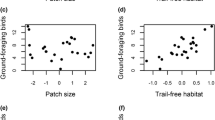Abstract
Relatively few studies have conducted quantitative assessments of historically important heritage trails. Their current conditions, relative to their long maintenance history, are even less well examined. This research aims to apply trail assessment techniques developed in a recreational context to the heritage trails of the Nakahechi route—which is part of the Kumano Kodo pilgrimage network—located in the vast forests of Japan’s Kii Peninsula. Point sampling was used to gather data on the trails’ surface characteristics, conditions, designs, and use-related variables. Trail conditions and design characteristics were summarized according to their surface characteristics, in order to identify the underlying environmental factors that potentially influenced the choice of different managerial methods. A series of exploratory multivariate regressions were then performed to examine the factors that influenced trail incisions. Regression analyses revealed that trail grades, trail widths, and use types are robust predictors for trail incisions. Managerial practices exemplified by the trails’ surface characteristics were found to influence trail design variables. For example, the additions of log water-bars and step construction on trail incisions along the trails were analyzed. The findings suggested that managers must address different trail characteristics when considering their historical context. Trail assessment surveys have been widely reported in the recreational literature, yet they have rarely been applied to heritage trails in mountainous areas. Assessing heritage trails, however, can be of great importance for their sustainable management.






Similar content being viewed by others
References
Birchard W, Proudman RD (2000) Appalachian trail design, construction, and maintenance, 2nd ed. Appalachian Trail Conference, Harpers Ferry, West Virginia
Bratton SP, Hickler MG, Graves JH (1979) Trail erosion patterns in Great Smoky Mountains National Park. Environ Manage 3(5):431–445
Chatterjea K (2007) Assessment and demarcation of trail degradation in a nature reserve, using GIS: case of Bukit Timah Nature Reserve. Land Degrad Dev 18:500–518
Cole ND (1983) Assessing and monitoring backcountry trail conditions. US Agriculture Department Forest Service research paper no. 303. US Department of Agriculture, Forest Service, Intermountain Forest and Range Experiment Station, Ogden, UT
Cole ND (1991) Changes on trails in the Selway-Bitterroot Wilderness, Montana, 1978–89. USAD Forest Service research paper no. 450. US Department of Agriculture, Forest Service, Intermountain Research Station, Ogden, UT
District Hongu (1983a) Rekishi-no-Michi (Kumano-Michi) Seibi-Houkokusho. Hongu District, Wakayama Prefecture (in Japanese)
District Nakahechi (1983b) Rekishi-no-Michi (Kumano-Michi) Seibi-Houkokusho. Nakahechi District, Wakayama Prefecture (in Japanese)
Garrod B, Fyall A (2000) Managing heritage tourism. Ann Tour Res 27(3):682–708
Knapp AR, Ducey JM (2009) A cost effective and efficient way to assess trail conditions: a new sampling approach. In: Proceedings of the 2009 George Wright Society Conference: Wilderness and Recreation Management, Portland, OR, pp 213–218
Leung Y, Marion JL (1999) Assessing trail conditions in protected areas: application of a problem-assessment method in Great Smoky Mountains National Park, USA. Environ Conserv 26:270–279
Li W, Ge X, Liu C (2005) Hiking trails and tourism impact assessment in protected area: Jiuzhaigou Biosphere Reserve, China. Environ Monit Assess 108(1–3):279–293
Liddle MJ (1997) Recreation ecology: the ecological impact of outdoor recreation and ecotourism. Chapman & Hall, London
Manning R, Jacobi C, Marion JL (2006) Acadia National Park visitor use and impact monitoring programs for carrying capacity decision-making. George Wright Forum 23(2):59–72
Marion JL, Leung Y (2001) Trail resource impacts and an examination of alternative assessment techniques. J Park Recreat Admin 19:17–37
Marion JL, Wimpey FJ, Park OL (2011) The science of trail surveys: recreation ecology provides new tools for managing wilderness trails. Park Sci 28(3):60–65
Nepal SK (2003) Trail impacts in Sagarmatha (Mt. Everest) National park, Nepal: a logistic regression analysis. Environ Manage 32(3):312–321
Nishikawa R (2014) Study of the historical routes policy by the Cultural Affairs Agency Research Collection of the Architectural Institute of Japan, Kinki, F-1, p 1111 (in Japanese)
Olive DN, Marion LJ (2009) The influence of use-related, environmental, and managerial factors on soil loss from recreational trails. J Environ Manage 90:1483–1493
Timothy JD (2011) Cultural heritage and tourism. Channel View, Bristol, UK
Tomczyk AM, Ewertowski M (2013) Quantifying short-term surface changes on recreational trails: the use of topographic surveys and “digital elevation models of differences” (DODs). Geomorphology 183:58–72
Törn A, Tolvanen A, Norokorpi Y, Tervo R, Siikamäki P (2009) Comparing the impacts of hiking, skiing and horse riding on trail and vegetation in different types of forest. J Environ Manage 90(3):1427–1434
Weaver T, Dale D (1978) Trampling effects of hikers, motorcycles and horses in meadows and forests. J Appl Ecol 15:451–457
Wimpey FJ, Marion LJ (2010) The influence of use, environmental and managerial factors on the width of recreational trails. J Environ Manage 91(10):2028–2037
World Heritage Center (2013) Operational guidelines for the implementation of the World Heritage Convention. http://whc.unesco.org/en/guidelines/. Accessed 24 May 2016
Acknowledgements
The corresponding author of this paper is truly grateful to the field staff working at the Wakayama Heritage Center, and is especially grateful to the director of the center, Mr Hiroshi Tsujibayashi, for his kind support and professional advice regarding the cultural properties of the study site. The authors would also like to thank Editage (www.editage.jp) for English language editing. We declare that the field surveys comply with the current laws of the country in which they were performed.
Author information
Authors and Affiliations
Corresponding author
Rights and permissions
About this article
Cite this article
Gou, S., Shibata, S. Assessing heritage trails: trail conditions and influential managerial factors for the Nakahechi route on the Kumano Kodo pilgrimage network. Landscape Ecol Eng 13, 251–263 (2017). https://doi.org/10.1007/s11355-016-0315-5
Received:
Revised:
Accepted:
Published:
Issue Date:
DOI: https://doi.org/10.1007/s11355-016-0315-5




